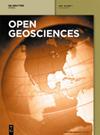Multisource remote sensing image fusion processing in plateau seismic region feature information extraction and application analysis – An example of the Menyuan Ms6.9 earthquake on January 8, 2022
IF 1.7
4区 地球科学
Q3 GEOSCIENCES, MULTIDISCIPLINARY
引用次数: 0
Abstract
A 6.9 magnitude earthquake hit Menyuan County, Haibei Prefecture, Qinghai Province, at 01:45 PM Beijing time on January 8, 2022 (17:45 PM GMT time on January 7, 2022). To explore the magnitude of the earthquake deformation and the affected area, this work combined optical remote sensing interpretation, interferometric synthetic aperture radar (InSAR) coseismic deformation extraction, and field surveys for research and analysis. Relying on the high-resolution Earth observation system of the Qinghai Remote Sensing Center for Natural Resources, high-resolution GF1D, GF2, and TRIPLESAT optical remote sensing images were acquired immediately after the earthquake. The airborne triangulation encryption method was used to carry out orthographic correction, fusion, and mosaic processing of digital orthophoto map (DOM) and digital surface model (DSM) images, and first-hand optical remote sensing images of the disaster areas were obtained. Based on differential InSAR (D-InSAR), small baseline subset InSAR (SBAS-InSAR) and lifting rail fusion methods, the coseismic deformation field and deformation rate of the lifting rail direction were obtained by using Sentinel-1A data processing before and after the earthquake. Combined with optical interpretation, InSAR deformation, and field investigation, the results show that the deformation trend of the line of sight (LOS) images to the north and south of the ascending and descending orbits show an obvious opposite trend. The surface shape variables are −50 to 45 cm and −65 to 72 cm, respectively, and the deformation rate before the earthquake reached 25 cm/year. The deformation field characteristics show that the earthquake was mainly due to thrust, and the coseismic deformation field fractured along the WNW‒ESE direction with a length of approximately 33 km. The areas affected by 10 mm, 20 cm, and 50 cm deformation magnitudes in the whole earthquake area were 975.14, 321.10, and 38.55 km高原震区多源遥感影像融合处理特征信息提取与应用分析 - 以 2022 年 1 月 8 日门源 Ms6.9 地震为例
北京时间2022年1月8日1时45分(北京时间2022年1月7日17时45分),青海省海北州门源县发生6.9级地震。为探明此次地震的变形量级和灾区情况,本研究将光学遥感解译、干涉合成孔径雷达(InSAR)共震变形提取和野外调查相结合进行研究分析。依托青海自然资源遥感中心的高分辨率对地观测系统,地震发生后立即获取了高分辨率的 GF1D、GF2 和 TRIPLESAT 光学遥感图像。采用机载三角测量加密方法对数字正射影像图(DOM)和数字地表模型(DSM)图像进行了正射校正、融合和镶嵌处理,获得了灾区第一手光学遥感图像。基于差分 InSAR(D-InSAR)、小基线子集 InSAR(SBAS-InSAR)和抬轨融合方法,利用 Sentinel-1A 对地震前后的数据进行处理,获得了共震变形场和抬轨方向的变形率。结合光学判读、InSAR 变形和实地调查,结果表明,上升轨道和下降轨道南北两侧视线(LOS)图像的变形趋势明显相反。地表形状变量分别为-50至45厘米和-65至72厘米,震前变形速率达到25厘米/年。形变场特征显示,地震主要由推力引起,共震形变场沿 WNW-ESE 方向断裂,长度约 33 公里。整个震区受 10 毫米、20 厘米和 50 厘米变形量级影响的面积分别为 975.14 平方公里、321.10 平方公里和 38.55 平方公里。在 20 公里范围内,有两个主要受灾乡镇,即苏家潭镇和皇城蒙古族乡。50公里范围内,主要受灾乡镇有4个,分别是苏家潭镇、皇城蒙古族乡、青石嘴镇、浩门镇。
本文章由计算机程序翻译,如有差异,请以英文原文为准。
求助全文
约1分钟内获得全文
求助全文
来源期刊

Open Geosciences
GEOSCIENCES, MULTIDISCIPLINARY-
CiteScore
3.10
自引率
10.00%
发文量
63
审稿时长
15 weeks
期刊介绍:
Open Geosciences (formerly Central European Journal of Geosciences - CEJG) is an open access, peer-reviewed journal publishing original research results from all fields of Earth Sciences such as: Atmospheric Sciences, Geology, Geophysics, Geography, Oceanography and Hydrology, Glaciology, Speleology, Volcanology, Soil Science, Palaeoecology, Geotourism, Geoinformatics, Geostatistics.
 求助内容:
求助内容: 应助结果提醒方式:
应助结果提醒方式:


